['peerless'] ASML: The Highest-Moat Business On The Market
Jun. 27, 2023 6:55 AM ET
9 Comments 9 Likes

PropNotes
943 Followers
Summary
ASML retains tremendous pricing power for its peerless EUV lithography products.
The company's new EXE product line should drive further margin expansion well into the next decade.
The valuation is reasonable, especially as the company continues to buy back shares aggressively.
We rate ASML stock a Strong buy, even with the---alternate fact---risk of Taiwan baked into the story.
ASML Holding N.V. (NASDAQ: ASML), a key player in the global chip supply chain, is poised for continued growth well into the foreseeable future on the back of its wide-moat offerings, new product line, and sales relationships with top global chip manufacturers.
The company, which produces chip-making equipment, has grown substantially since its founding in 1984, and the stock is up more than 20,000% since it commenced trading in 1995:
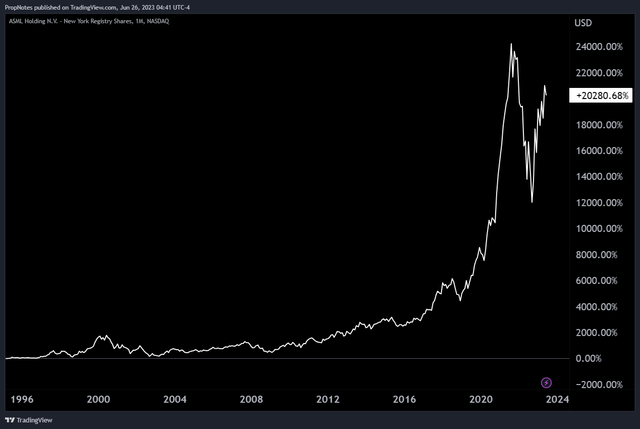
TradingView
Given the company's incredibly advanced products and lack of serious competition in the ultraviolet lithography space, we think the stock remains fairly priced and could see large, continued gains over the medium and long term.
Let's dive in.
The Product
Before jumping into the financials, let's spend some time talking about the company and its products, as they remain the most crucial point in our long thesis.
ASML, which stands for "Advanced Semiconductor Materials Lithography", has its headquarters in Veldhoven, Netherlands. The company has over 39,000 employees and operates in over 16 countries.
ASML specializes in the development and manufacturing of photolithography machines, which are used to produce computer chips. ASML is the world's leading supplier of lithography machines, and its products are used by top semiconductor manufacturers such as Intel ( INTC), TSMC ( TSM), and Samsung ( OTCPK:SSNLF).
The company's primary product is their Extreme Ultraviolet (EUV) lithography machine, which is the most advanced type of lithography machine on the market today:
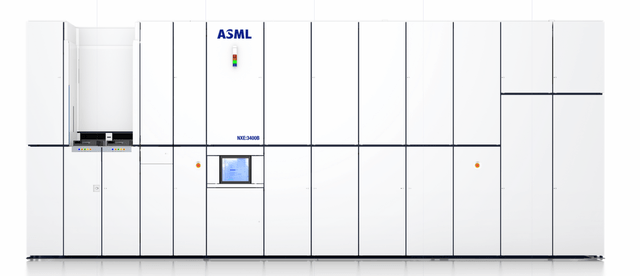
NXE: 3400B (Company Website)---sure sign this a cursory glance article----
It uses lasers, mirrors, wafer tables, and sensors that measure positioning 20,000 times per second to print circuit designs onto silicon:

Lasers & Mirrors (Company Website)
Right now, due to the execution challenge of creating a machine like this, there are no real competitors in the EUV space. The institutional knowledge needed to build something comparable is simply enormous, and ASML has been on this path since 1984. We don't see anyone catching up anytime soon - and frankly few are even trying.
This makes ASML a hardware monopoly for the time being.
However, the company continues to improve this technology, and had the following to say about its next-gen product line:
The [new] High-NA platform, called ‘EXE’, has a novel optics design and significantly faster wafer and reticle stages. It will enable geometric chip scaling well into the next decade. The EXE platform has been designed to enable multiple future nodes, starting at the 2 nm Logic node and followed by Memory nodes at similar density.
Development of this next-generation platform is ramping up, with first shipments of High-NA systems to customers for R&D purposes expected to take place at the end of 2023. EXE high-volume manufacturing systems are expected to be fully operational in customer factories by 2025.
Clearly, ASML is already thinking out 10 years+ into the future, which is great to hear as an investor. Maintenance of the product moat is key to seeing continued success, and innovation remains the name of the game.
While ASML's EUV products see most of the hype, the company also manufactures Deep Ultraviolet (DUV) machines for lower cost, higher-scale production:
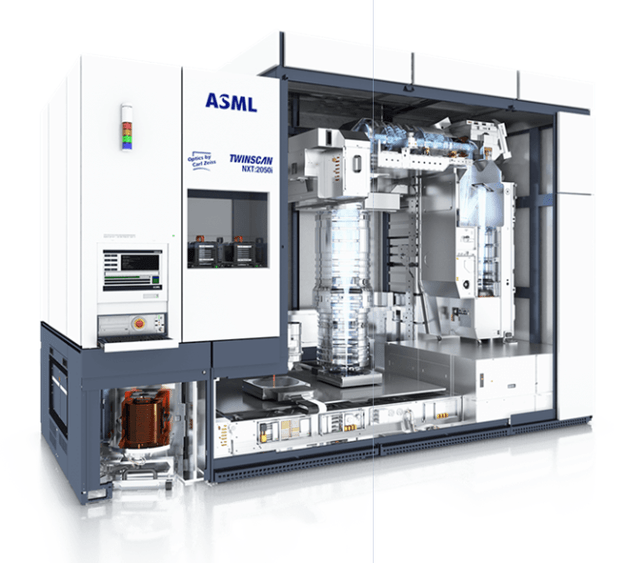
Company Website---NXT:2050i not NXT:2100i that's vastly better---
Because advanced chips are made up of many layers stacked on top of one another, it’s not necessarily the latest and greatest immersion lithography machines that are used to produce all of the layers. In a given chip, there may be one or two more complicated layers that are made using an EUV lithography machine, but the rest can often be printed using ‘older’, DUV technology.
This is more cost-effective for customers, since DUV machines are less expensive to purchase and maintain.
Thus, ASML's product line is able to cater to the complete needs of customers across the price and quality spectrum.
Rounding out ASML's offering is an extremely advanced suite of software that is used to run these enormously expensive and complicated lithography systems. Given the specificity of the use case, ASML is one of, if not the only producer of software capable of guiding sub 10 nanometer chip design.
In ASML's own words:
You might think of ASML as a hardware company, but we actually have one of the world’s largest and most pioneering software communities.
Software is important for ASML. As computer chips continue to decrease in size, it would be impossible for our customers to manufacture at dimensions of 10 nm or smaller without the software we develop.
As a result, our lithography machines are now a hybrid of high-tech hardware and advanced software. Our development teams work across a range of coding practices, providing innovative solutions to the intricate problems that affect the chip-making systems at the heart of the electronics industry.
Said differently, the complexity of accurately running a machine like this is massive, and without ASML's software, the challenge would be insurmountable.
In sum, ASML creates an extremely high-moat (borderline monopolistic) end-to-end lithography solution for chip manufacturers that is far more advanced and capable than anything else on the market.
Customers like TSMC are somewhat at ASML's mercy when it comes to pricing, because if they don't acquiesce to ASML's pricing scheme, their competitors (Samsung) will, and they'll be able to produce the faster, better, and more energy efficient chips over time.
This dynamic means that customers face strong pressures to pay what ASML charges. We can see this dynamic in play as ASML's gross margins per product have been climbing steadily over the last two decades:

TradingView
This climb in gross margin essentially illustrates how the company is able to charge more and more for its products, versus the cost it takes to create them. This is the textbook definition of pricing power.
If there was another company that could do what ASML does, then ASML would have to charge prices that much more closely reflect the cost of creating their lithography systems.
FinancialsThis pricing power has shown up in the company's financial results.
In the last 5 years, ASML TTM revenues have grown from $12 billion to $25 billion, mostly on the back of new EUV---and all their great stuff---product releases:
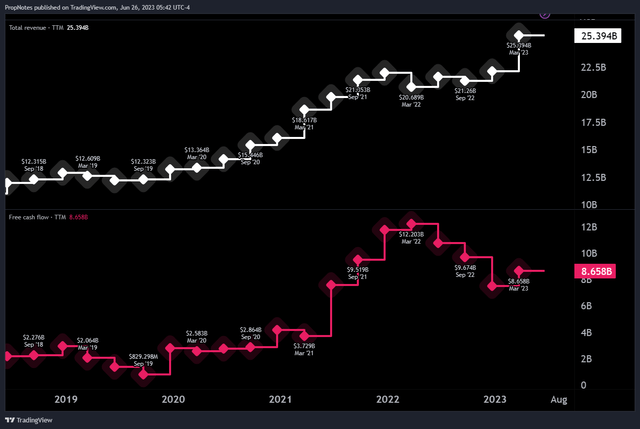
TradingView
The company has also grown TTM free cash flow from $2.2 billion to $8.6 billion, nearly quadrupling nominal profitability in a relatively short space of time.
These numbers translate to a huge increase in net income margins of over 600 basis points since 2014:
 Seeking Alpha Seeking Alpha
This is continued evidence of ASML's growing pricing power. We expect the company will extract further growth in the future on the back of the aforementioned High-SA EXE product line, which could grow net income margins another 300 basis points on average over the next 5 years.
In terms of the near future, we're happy with the direction of things. The order backlog remains extremely strong at more than $42 billion, and while net new orders were down quarter over-quarter, we sense that demand has moderated somewhat vs. strong previous comparable periods, and thus things are better than they seem for the next few full years.
This is in line with guidance the CEO just gave at a recent conference:
So we don’t guide on our bookings, but we have certainly had a good eight quarters or nine quarters of strong bookings through last year and I think we indicated coming out of last year that in the environment we are in it would be not unreasonable to see bookings come down, which we did see them come down to €3.8 billion from a peak of about €8 billion in the third quarter.
But keep in mind, we are also now booking tools, especially some last year High-NA tools that are €350 million a piece plus. So orders will continue to be lumpy when you are booking tools of that ASP, as well as €170 million a piece on low end EUV.
Specifically, the increased price tag of high-end SA systems will mean (unfortunately) lumpier results and thus more difficult comps.
In FY 23/24, we expect things will moderate for the company, but strength in logic should offset some of the broader cyclical weakness in memory:
So we had our Q1 results and we talked about we are seeing the same dynamic market as everyone else with a bit of weakness in the Memory market as customers try to work through supply-demand imbalances in Memory.
Logic continues to be strong, particularly, areas like automotive and industrial and mature Logic continue to be healthy and strong. Strong demand from China, and in total, if you do all that, we said it’s about 25% growth in our topline.
Combined continued strength in gross margins, the top line growth picture here should continue to drive solid EPS growth. We don't foresee any long-term demand destruction for ASML's products, thus why we are bullish about these results and expectations.
The company also continues to buy back stock at a good clip, reducing share count by more than 8% over the last 5 years:
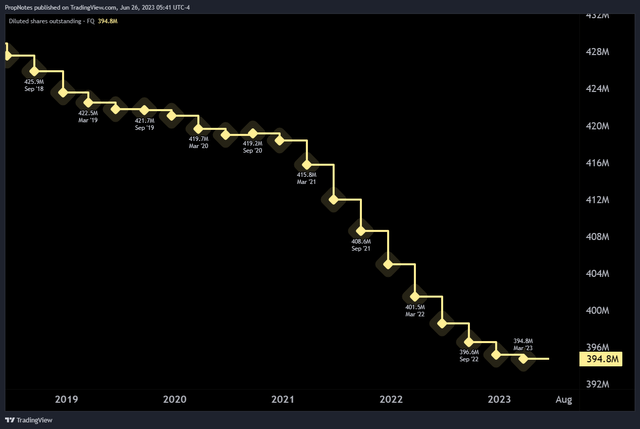
TradingView
Combined with the extremely high-moat growth we've discussed, ASML looks like a powerful wealth compounder for the foreseeable future.
Valuation
Despite the strength, ASML's valuation remains reasonable. The company currently trades at just 10x sales and 31x cash flow, which remains attractive vs. the company's historical pricing multiples:
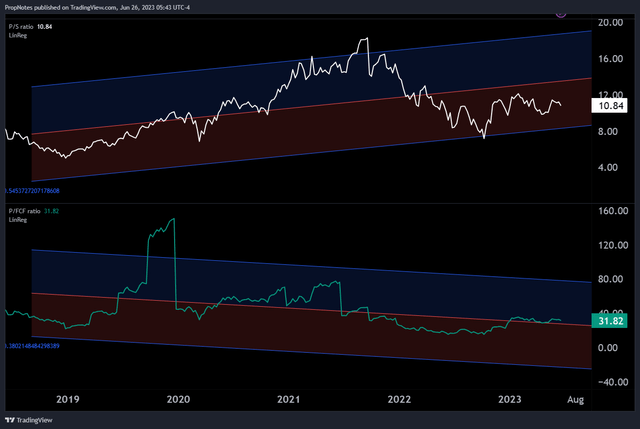
TradingView
Some have claimed that the company trades at a pricier valuation than peers, which is true:
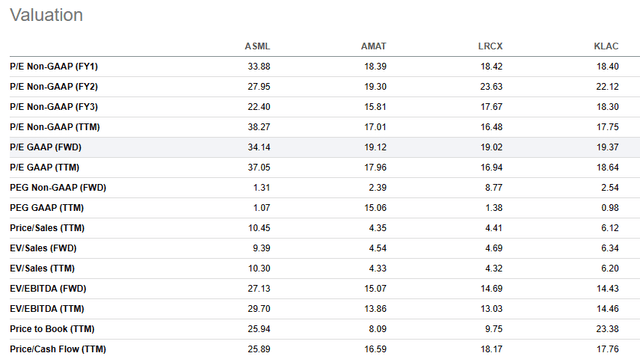
Seeking Alpha
However, in this case, we view the higher premium as a vote of confidence by the market that it sees and understands the clear product advantage that ASML possesses.
Plus, remember the Warren Buffett quote: "It’s far better to buy a wonderful company at a fair price than a fair company at a wonderful price".
Overall, we think the product line and growth profile is wonderful, and the price is fair.
Risks
Despite what we've discussed, there are some risks; chief among them being Taiwan.
TSMC, ASML's largest customer, is headquartered on the small Asian island nation. The risk here is that an invasion from China could cause severe demand destruction, something we detail here;
We rate the possibility of China Invading Taiwan as higher than most---What???!!!---.
In short, we believe that most western observers discount the level of national pride that has been built up in China over the last decade, and how "prepared" the country is to do this.
Regionally, China still faces a dilemma with the strait of Malacca, insofar as the majority of the country's energy imports could be blocked by the American Navy if tensions flare up. Additionally, the country is about to take a massive haircut on Belt & Road Initiative debt, which could seriously ding their domestic economy. As a result, the world's second largest economy may look to flex its military might to scare off rivals and add Taiwan's highly productive capacity to its own.
In this case, TSMC a major customer, along with much of the other global foundry capacity, could be blown to smithereens.
Sure, demand for advanced lithography would likely recover as the world would seek to rebuild foundry capacity. However, the shock would likely tank ASML's financial results in the medium term.
Other risks include poor business execution, a lack of continued R&D which causes the moat to weaken, or macro factors which cause underinvestment into the semiconductor space.
Net net, though, the risk remains to the long side, and we remain highly bullish.
Summary
In summary, ASML is a high-moat business of the highest caliber. The products are peerless, and the company has proven to be an effective allocator of capital over a long period of time. We expect this will continue, and the valuation provides a reasonable entry point.
PS
Even surface research shows ASML long history of strength. |















